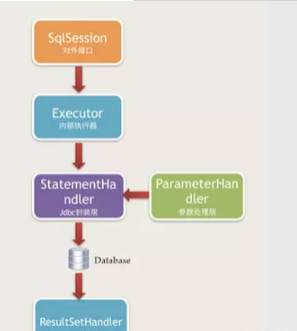更新时间:2021-07-16 15:56:40 来源:动力节点 浏览1489次
当我们使用Mybatis的时候,总会使用到各种插件,如PageHelper(分页插件)等,当我们需要自定义插件来改变,就必须了解插件的实现原理。
Mybatis插件又称拦截器,Mybatis采用责任链模式,通过动态代理组织多个插件(拦截器),通过这些插件可以改变Mybatis的默认行为。MyBatis允许你在已映射语句执行过程中的某一点进行拦截调用。默认情况下,MyBatis允许使用插件来拦截的方法调用包括:

上图Mybatis框架的整个执行过程。Mybatis插件能够对则四大对象进行拦截,可以包含到了Mybatis一次会议的所有操作。可见Mybatis的的插件很强大。
public ParameterHandler newParameterHandler(MappedStatement mappedStatement, Object parameterObject, BoundSql boundSql) {
ParameterHandler parameterHandler = mappedStatement.getLang().createParameterHandler(mappedStatement, parameterObject, boundSql);
parameterHandler = (ParameterHandler) interceptorChain.pluginAll(parameterHandler);
return parameterHandler;
}
public ResultSetHandler newResultSetHandler(Executor executor, MappedStatement mappedStatement, RowBounds rowBounds, ParameterHandler parameterHandler, ResultHandler resultHandler, BoundSql boundSql) {
ResultSetHandler resultSetHandler = new DefaultResultSetHandler(executor, mappedStatement, parameterHandler, resultHandler, boundSql, rowBounds);
resultSetHandler = (ResultSetHandler) interceptorChain.pluginAll(resultSetHandler);
return resultSetHandler;
}
public StatementHandler newStatementHandler(Executor executor, MappedStatement mappedStatement, Object parameterObject, RowBounds rowBounds, ResultHandler resultHandler, BoundSql boundSql) {
StatementHandler statementHandler = new RoutingStatementHandler(executor, mappedStatement, parameterObject, rowBounds, resultHandler, boundSql);
statementHandler = (StatementHandler) interceptorChain.pluginAll(statementHandler);
return statementHandler;
}
public Executor newExecutor(Transaction transaction, ExecutorType executorType, boolean autoCommit) {
executorType = executorType == null ? defaultExecutorType : executorType;
executorType = executorType == null ? ExecutorType.SIMPLE : executorType;
Executor executor;
if (ExecutorType.BATCH == executorType) {
executor = new BatchExecutor(this, transaction);
} else if (ExecutorType.REUSE == executorType) {
executor = new ReuseExecutor(this, transaction);
} else {
executor = new SimpleExecutor(this, transaction);
}
if (cacheEnabled) {
executor = new CachingExecutor(executor, autoCommit);
}
executor = (Executor) interceptorChain.pluginAll(executor);
return executor;
}
这4个方法实例化了对应的对象之后,都会调用interceptorChain的pluginAll方法,那么下面我们在来看pluginAll干了什么
public class InterceptorChain {
private final List<Interceptor> interceptors = new ArrayList<Interceptor>();
public Object pluginAll(Object target) {
for (Interceptor interceptor : interceptors) {
target = interceptor.plugin(target);
}
return target;
}
public void addInterceptor(Interceptor interceptor) {
interceptors.add(interceptor);
}
public List<Interceptor> getInterceptors() {
return Collections.unmodifiableList(interceptors);
}
}
原来这个pluginAll方法就是遍历所有的拦截器,然后顺序执行我们插件的plugin方法,一层一层返回我们原对象(Executor/ParameterHandler/ResultSetHander/StatementHandler)的代理对象。当我们调用四大接口对象的方法时候,实际上是调用代理对象的响应方法,代理对象又会调用四大接口对象的实例。
拦截器Interceptor
Mybatis的插件实现要实现Interceptor接口,我们看下这个接口定义的方法。
public interface Interceptor {
Object intercept(Invocation invocation) throws Throwable;
Object plugin(Object target);
void setProperties(Properties properties);
}
这个接口只声明了三个方法。
官方推荐插件开发方式
@Intercepts({@Signature(type = Executor.class, method = "query",
args = {MappedStatement.class, Object.class, RowBounds.class, ResultHandler.class})})
public class TestInterceptor implements Interceptor {
public Object intercept(Invocation invocation) throws Throwable {
Object target = invocation.getTarget(); //被代理对象
Method method = invocation.getMethod(); //代理方法
Object[] args = invocation.getArgs(); //方法参数
// do something ...... 方法拦截前执行代码块
Object result = invocation.proceed();
// do something .......方法拦截后执行代码块
return result;
}
public Object plugin(Object target) {
return Plugin.wrap(target, this);
}
}
简单编写Mybatis插件
注:MyBatis默认没有一个拦截器接口的实现类,开发者可以实现符合自己需求的拦截器。
下面的MyBatis官网的一个拦截器实例:
@Intercepts({@Signature(type= Executor.class, method = "update", args = {MappedStatement.class,Object.class})})
public class ExamplePlugin implements Interceptor {
public Object intercept(Invocation invocation) throws Throwable {
return invocation.proceed();
}
public Object plugin(Object target) {
return Plugin.wrap(target, this);
}
public void setProperties(Properties properties) {
}
}
全局xml配置:
<plugins>
<plugin interceptor="org.format.mybatis.cache.interceptor.ExamplePlugin"></plugin>
</plugins>
这个拦截器拦截Executor接口的update方法(其实也就是SqlSession的新增,删除,修改操作),所有执行executor的update方法都会被该拦截器拦截到。
以上就是动力节点小编介绍的"Mybatis插件原理",希望对大家有帮助,想了解更多可查看Mybatis视频教程。动力节点在线学习教程,针对没有任何Java基础的读者学习,让你从入门到精通,主要介绍了一些Java基础的核心知识,让同学们更好更方便的学习和了解Java编程,感兴趣的同学可以关注一下。
 Java实验班
Java实验班
0基础 0学费 15天面授
 Java就业班
Java就业班
有基础 直达就业
 Java夜校直播班
Java夜校直播班
业余时间 高薪转行
 Java在职加薪班
Java在职加薪班
工作1~3年,加薪神器
 Java架构师班
Java架构师班
工作3~5年,晋升架构
提交申请后,顾问老师会电话与您沟通安排学习